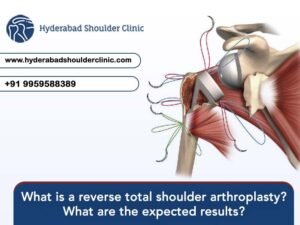Do you feel severe pain in the shoulder when moving and while resting? Does pain affect sleep? If your mobility is limited in any way, especially while rotating the arm above shoulder level, you may be suffering from frozen shoulder syndrome.
Frozen shoulders, also known as Adhesive Capsulitis, is difficult to bear. Frozen shoulder is a disease that attacks your shoulder joint. Usually, pain and stiffness develop gradually, get worse, and eventually disappear. After a period of worsening frozen shoulders tend to improve, although full recovery can take up to 3 years.
Understanding Frozen Shoulder

The shoulder consists of three bones that form a connection called a ball and the socket joint. They are your upper arm humerus, scapula (shoulder blade), and clavicle (collar bone). There is also tissue around your shoulder joints that holds everything together. It is called a shoulder capsule. In a frozen shoulder, the capsule becomes so thick and hard that it is difficult to move. Scar tissue forms and there is less amount of fluid called synovial fluid to keep it lubricated together. These things limit the movement even more.
If you have frozen shoulders, you know how painful it is in the shoulders and arms. It seems almost impossible to do simple tasks like dressing and bathing. There is often little or no injury, and there is no specific shoulder test to determine if you have frozen shoulders. A frozen shoulder sign is easily seen: limited and painful freedom of movement (ROM) on your shoulder. If your shoulders freeze, a visit to your physical therapist can help restore the normal use of your arm. Your PT can help ease your pain and provide strategies to help you use your arms normally. Physiotherapy with a focus on shoulder flexibility is the primary recommendation for treatment of the frozen shoulder.
This article was provided by Dr Chandra Sekahr. B gives the information about the frozen shoulder and how to cure frozen shoulders quickly.
What causes frozen shoulders?

A frozen shoulder is the result of scarring, inflammation, shrinkage, and thickening of the capsule that surrounds the normal shoulder joint. Any shoulder injury can cause frozen shoulder, including tendinitis, bursitis, and rotator cuff syndrome. This is more common in patients with risk factors for diabetes, chronic shoulder arthritis, or after breast surgery. Prolonged shoulder joint immobility can increase the risk of developing frozen shoulders. Frozen shoulder most often affects people aged between 40 and 60 years and is more common in women than men.
Stages of Frozen joints:

Symptoms are usually divided into three stages because they gradually get worse and then disappear within 2 to 3 years.
- Freezing, or painful stage: Pain gradually increases, which makes shoulder movements more difficult and stronger. The pain is usually worse at night. This phase can last from 6 weeks to 9 months.
- Frozen: The pain does not worsen and can be reduced at this stage. Shoulders remain stiff. It can take 4 to 6 months, and movement can be restricted.
- Thawing: Movement becomes more comfortable and eventually returns to normal. The pain can subside, but sometimes it returns. It takes between 6 months and two years.
More than 90 per cent of people find that symptoms improve with simple exercise and pain control. A frozen shoulder usually recovers but can take three years.
What are the symptoms and signs of a frozen shoulder?

Symptoms and signs of frozen shoulder include shoulder pain, stiffness, and loss of freedom of movement. The range of shoulder movement is limited when the patient tries to move the joint. The shoulder can experience increased pain when used. These symptoms can make sleep very uncomfortable. So let us see how to treat frozen shoulders quickly.
How to treat frozen shoulder?
The aim is to relieve pain and maintain shoulder flexibility and mobility. After treatment, 9 out of 10 patients experience relief. However, recovery can be slow, and symptoms can last for several years. You can leave the frozen shoulder untreated, but the pain and stiffness can last for up to three years. There are several ways to relieve pain and alleviate the condition. The following combination of options can speed up your recovery:
- Physical therapy
- Medication
- Home care
- Surgery
Physical Therapy:

Physiotherapy is the most common treatment for frozen shoulders. The aim is to stretch the shoulder joint and regain lost movement. Progress can take anywhere from a few weeks to nine months. If you don’t see any improvement after six months of exercise every day, talk to a doctor about other options. stretching exercises that are useful include:
- Walking the fingers up the wall
- Bringing both the hand forward holding one arm with the other and pulling it across the chest
- Rotating the arm with a cane or broomstick
- Pulling the arm behind the back
After the shoulder becomes less painful at rest, physical therapy and stretching can help restore lost movement. You can also try other pain relief techniques, such as Hot or cold temperature packs and transcutaneous electrical nerve stimulation devices (TENS).
Home care:

If you put an ice pack on your shoulder for 15 minutes several times a day, you can relieve pain. If you work with a physiotherapist, exercise can be done at home. Your physical therapist will give you instructions on what type of exercise you should do, how often you do it, and when you should push harder. Most people with frozen shoulders can improve their condition without surgery.
- Hot or cold compression packs: They can relieve pain and swelling. Alternating between the two can help. They can be purchased online.
- Transcutaneous electrical nerve stimulation (TENS): This works by numbing nerve endings in the spinal cord that control pain. The TENS device sends small electrodes or small electric pads that are applied to the skin of the affected shoulder. Different TENS machines from various brands can be purchased online.
Medications:
To treat pain and reduce joint inflammation, a doctor may recommend anti-inflammatory drugs Steroid injections into your shoulder joint can also help.
Painkillers: Nonsteroidal anti-inflammatory drugs (NSAIDs) can reduce inflammation and reduce mild pain. As not all painkillers are suitable for every patient, it is important to discuss options with a doctor.
Steroid injections:
Corticosteroid injections into the shoulder joint can help ease pain and increase shoulder mobility, especially in the early stages of the process.
Joint detention:
Injecting sterile water into a joint capsule can help stretch the tissue and facilitate joint movement.
Surgery:

If your symptoms do not improve with therapy and other conservative methods, your doctor can recommend surgery. It is essential to talk with your doctor about your recovery potential, the continuation of simple treatments, and the risks associated with surgery. The purpose of this surgery is to stretch and release the stiff capsule of the joint. The most common methods are manipulation under anaesthesia and shoulder arthroscopy.
Surgery is usually done on an outpatient basis. Your stitches will most likely be removed in 10 days. Postoperative physical therapy is usually required. Many patients have a full range of movement backwards within three months. Surgery carries risks. Therefore, talk with a doctor before deciding on the procedure. Surgery techniques used include:
Manipulation: This is a procedure where the surgeon moves the shoulder when you are under anaesthesia. The doctor then moves the shoulder joint in various directions to loosen tight tissue.
Arthroscopic capsular release: This is a relatively small operation performed as a “key” operation. In this procedure, the tight capsule from the joint is removed with a special probe.
Frozen shoulder surgery is rare, but if nothing else helps, your doctor may recommend surgery to remove scars and adhesions on the inside of the shoulder joint.
Conclusion:
If you have frozen shoulders, call a doctor to make sure you receive adequate care. Physical therapy can certainly help you control your pain and increase shoulder mobility so you can get back to your normal activities. A frozen shoulder can only be prevented if it is caused by an injury that makes the shoulder unable to move. Anyone who suffers from an injury should talk with a doctor about exercises to maintain mobility and flexibility of the shoulder joint.
Symptoms of a frozen shoulder can last between 18 months and three years or more. Most people with frozen shoulders recover to normal levels of function and movement within two years, even without treatment. Most frozen shoulder treatments involve controlling shoulder pain and maintaining as much movement as possible on the shoulder. It is recommended to seek advice from Dr Chandra Sekhar. B if pain continues after a long period of rest or home treatment. For more information about frozen shoulder and treatment contact, Dr Chandra Sekhar .B at 91 9959588389.





